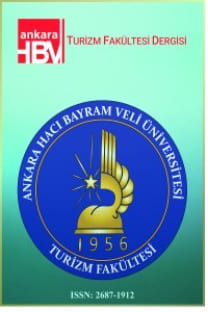General Overview of Training Effectiveness and Measurement Models
Bir örgüt başarılı olmak ve bunu sürdürmek için, sürekli öğrenmek ve gelişmek isteyen insanlardan oluşan işgücünü oluşturmalı ve bunu koruyabilmelidir. İş gücünün gelişimi ve eğitimi, becerikli işgücünü koruyabilmek ve etkin bir yönetim sağlayabilmek için oldukça önemlidir. Eğitim örgütün, etkinliğini geliştirebilmenin bir yoludur. Örgütler, doğru eğitim programlarını uygulayabilmek için, eğitim yöntemlerinin ve bu yöntemlerin etkinliğinin farkında olmalıdır. Çalışma, eğitim programı oluştururken hangi eğitim yönteminin ne zaman uygulanabileceğine dair kavramsal bir duruş sergilemektedir.İş dışında ve işbaşında eğitim yöntemlerinin güçlü ve zayıf yönleri tartışılmış, bununla birlikte, eğitim etkinliğini belirleyebilmek için koşul olan ölçüm modellerine de yer verilmiştir. Bu çalışma eğitim yöntemlerine ve ölçüm modellerine genel bir bakış açısı sunmaya çalışmıştır
Anahtar Kelimeler:
Eğitim, iş dışında eğitim, iş başında eğitim, ölçüm, etkinlik
EĞİTİM METOTLARININ ETKİNLİĞİNE VE ÖLÇÜM MODELLERİNE GENEL BİR BAKIŞ
S Any organization that wants to succeed, and to continue to succeed, has to maintain workforce consisting of people who are willing to learn and develop continuously. Training and developing human capital is tremendously important in the effective management and maintenance of a skilled workforce. Training is one of the ways of improving organization’s effectiveness. In order to implement right training methods, organization should be aware of the training methods and their effectiveness. Study provides conceptual framework of determining which methods to use when developing training program. The various training methods- both off-the-job and on-the-job- are described along with their strengths and limitations. Paper also explores the measurement methods of training evaluation which is very crucial for the training effectiveness. This study tries to give general overview of training methods and measurement models
Keywords:
training, on-the-job training, off-the-job training, measurement, effectiveness,
___
- BENTLEY T. (1990), The Business of Training, , 2nd edition, Mc Graw Hill Book Company, New Jersey.
- BLANCHARD P. N. and Thacker J.W. (1998), Effective Training: Systems, Strategies and Practices, Prentice Hall, New Jersey.
- DECKER P. and Naten B. (1985), Behaviour Modeling Training: Principles and Applications, Prager, NY.
- DOE, (January 1995), Alternative Systematic Approach to Training, HANDBOOK 1074.
- DRUMMOND K.E. (1989), Human Resource Management for the Hospitality Industry, Van Nostrand Reinhold, NY.
- DUNETTE M. (1976), Aptitudes, Abilities and Skills, Randy Macnally, Chicago.
- FLEISHMAN E, (1972), “On The Relation Between Arbilities, Learning And Human Performance”, American Psychologist, 27:1017.
- GOLDSTEIN L. (1993), Training in Organizations, , Pacific Grove CA: Brooks/Cole.
- JERRIS L.A. (1999), Human Resources Management for Hospitality, Prentice Hall, New Jersey.
- KAPLAN R. and at all Lombardo M. Mazique M., (1985), “ A Mirror for Managers: Using Simulation to Develop Management Teams”, , Journal of Applied Behavioural Science, 21:241.
- KEASRLY G., (1984), Training and Technology, Addison-Wesley, NY.
- KING, D, (1968), Training within the Organization, Cox & Wyman Ltd.
- KIRWAN T. H. (2000), “Coaching Champion”, Management Today, November.
- KRAIGER, F. and Salas E. (1993), “Application of Cognitive, Skill based and Affective Theories of Learning Outcomes to New Methods of Training Evaluation”, Journal of Applied Psychology, 78:2.
- LEE Katherine, March (2000), “The Future of Training Programs”, www.hr.com.
- MCNAMARA C. (May 2000), “Various Ideas for Learning Activities and Documentation Results”, www.mapnp.com.
- NEWMAN D. and Hodgets R.(1998), Human Resource Management, Prentice Hall, New Jersey.
- PARRY S.(1996) “Measuring Training’s ROI”, Training and Development, May 50:5.
- PHILLIPS, J. (1997), Handbook of Training Evaluation and Measurement Methods, Houston Gulf, Texas.
- PIGORS P. and Pigors F., (1987), The Case Method, in Training and Development Handbook, McGraw Hill, London.
- SHEPHERD C., (1999), “Assesing the ROI of Training”, www.fastrak-conculting.com.uk.
- STONE J. and Watson V., (1999), “Evaluation of Training”, www.ispi-atlanta.org.
- SULLIVAN J. (June 1999), “Why Corporate Training Does not Work”, www.hr.com.
- WOODS, R., (1995), Human Resources Management, AHMA, Michigan.
- ISSN: 2687-1912
- Yayın Aralığı: Yılda 2 Sayı
- Başlangıç: 1998
- Yayıncı: Ankara Hacı Bayram Veli Üniversitesi
Sayıdaki Diğer Makaleler
Marka ve Bilinirliği Yüksek Markalı Çamaşır Deterjanı Üzerine Bir Uygulama
Alptekin SÖKMEN, İrfan YAZICIOĞLU
1007 Nolu Uluslararası Denetim Standardı "İşletme Yönetimi İle Bilgi Alışverişi"
Hizmet Sektöründe Tüketicilerin Algıladıkları Riskler: Hava Yolları Sektöründe Bir Araştırma
Kültürel Turizmin Önemi ve Tüketici Tercihlerinin Belirlenmesine Yönelik Bir Çalışma
İsmail KIZILIRMAK, Hüseyin KURTULDU
General Overview of Training Effectiveness and Measurement Models
Antalya İline Yönelik Alman Turist Talebinin Yapay Sinir Ağları Yöntemiyle Tahmini
1007 Nolu Uluslararası Denetim Standardı "İşletme Yönetimi İle Bilgi Alışverişi"
